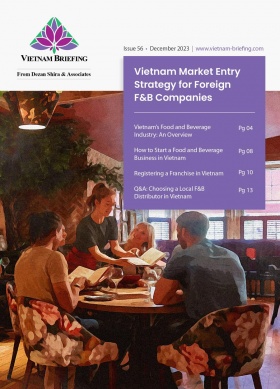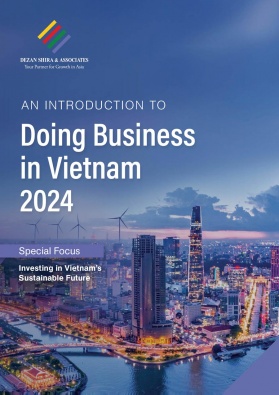Unlocking Investment Opportunities: Vietnam’s Q1 Business Activity Rebound
We note the increased business activity seen in Q1 2024 across key sectors in Vietnam and briefly discuss the opportunities it presents for investors.
After a challenging 2023, the first quarter (Q1) of 2024 has brought a wave of optimism for local businesses across various sectors in Vietnam. From textiles to petroleum, banking to retail, key industries are reporting upbeat results, signaling a potential turnaround, and setting the stage for a year of growth and opportunity.
READ: Vietnam’s State of the Economy: Q1 2024 Report
Sector prospects for Vietnam investors
Capitalizing on a rebound in the textile and garment sector
Leading the charge in Vietnam’s uptick in business activity is the textile and garment industry, with Thanh Cong Textile Garment Investment Trading JSC (TCM), Vietnam National Textile and Garment Group (Vinatex), Dong Xuan Knitting Single Member Company Limited, and Garment 10 Corporation posting impressive revenue gains in Q1. TCM’s Chairman, Tran Nhu Tung, expressed confidence in meeting ambitious targets for the year, reflecting positive sentiments in the sector.
Garment 10 Corporation reported a substantial revenue increase of 24.2 percent in Q1, driven by both export and domestic market endeavors. The company remains optimistic about its prospects for Q2 and beyond, with plans underway for expansion, including the establishment of fashion centers and retail stores across the country.
Dong Xuan Knitting Single Member Company Limited is reportedly experiencing a surge in fabric orders, with projections of increased production in the coming months.
Vietnam National Textile and Garment Group (Vinatex) achieved a notable 20 percent year-on-year increase in sales and profit in Q1, credited to proactive management and flexibility, according to CEO Cao Huu Hieu.
Reports suggest a positive turnaround for Vietnam’s textile industry in the second quarter, with orders on the rise, indicating a gradual recovery, according to Vu Duc Giang, Chairman of the Vietnam Textile and Apparel Association. The sector saw a notable 9.62 percent increase in textile and garment export turnover in the first quarter of 2024, totaling over US$9.53 billion, as highlighted by Giang. This trend, along with continued preference for Vietnam as a manufacturing hub, hints at a potential export turnover of US$44 billion for the year.
Investors in the textile and garment sector should focus on meeting the escalating demand. This includes optimizing production capacity, streamlining supplier networks, and enhancing product quality to maintain competitiveness in both domestic and international markets. Successful integration into global value chains will necessitate investments in technology, sustainability practices, and diversification of products and customers.
Riding the wave of petroleum sector growth with a focus on renewables
Favorable global market conditions have fueled the growth of the petroleum sector, exemplified by PetroVietnam Oil Corporation (PVOIL). With significant revenue and profit increases in Q1, PVOIL is poised for further expansion, highlighting the sector’s resilience and potential for sustainable growth.
The Vietnamese state-owned oil and gas company PVN and Danish fund manager CIP recently formalized their partnership to expedite Vietnam’s shift towards renewable energy sources. Speaking to media, CIP board member Robert Helms stated that CIP will cooperate with PVN on the R&D for offshore wind power projects in Vietnam. In January 2024, CIP set up the Copenhagen Energy Islands (CEI) venture to implement renewable energy projects across the North Sea, Baltic Sea, and Southeast Asia, with a focus on offshore wind.
Companies operating in this sector can leverage this momentum by expanding operations, investing in sustainable infrastructure, and exploring new avenues for revenue generation such as renewable energy initiatives.
Vietnam has the most operating utility-scale solar and wind capacity of all the ASEAN nations – at 19GW versus 9GW across the rest of ASEAN, per data from Carbon Brief. Vietnam has deployed a series of investment policies designed to bring utility scale-solar projects into operation, such as the feed-in-tariff (FiT) programs (2017 to 2023). However, lapses in energy policies have seen some years add more renewables capacity than other years.
In late 2022, Vietnam, alongside Indonesia, became a beneficiary of the JETP (Just Energy Transition Program). This initiative is geared towards accelerating Vietnam’s shift away from fossil fuels by retiring coal plants and enhancing energy infrastructure to facilitate the adoption of renewable energy sources. Under the JETP, Vietnam is set to receive US$15.5 billion over a span of three to five years, with funding primarily sourced from the International Partner Group (IPG). The IPG comprises Canada, Denmark, the EU, France, Germany, Italy, Japan, Norway, the U.K., and the U.S., along with various private sector investments from multilateral and national development banks.
In mid-2023, Vietnam established its own JETP secretariat to collaborate with the IPG in overseeing and implementing the commitments outlined in the partnership’s declaration. This secretariat also formulated Vietnam’s Resource Mobilization Plan, detailing changes to the national energy regulatory framework, reform targets for the energy sector, and a monitoring framework for tracking challenges and progress under the JETP.
To achieve the JETP’s objectives, the government revised energy policies to increase the proportion of renewable energy sources. In May 2023, the Power Development Plan 8 (PDP8) was announced, aiming to raise the share of electricity from renewables (excluding hydropower) to over 30 percent by 2030, with a target of 47 percent by leveraging support from the JETP.
In August 2023, the government endorsed the National Energy Master Plan (NEMP), outlining a pathway for Vietnam to attain net zero emissions by 2050 and ensure sustainable energy for economic growth. The plan emphasizes rapid renewable energy deployment, aiming for renewables to constitute 85 percent of the country’s power supply by 2050. However, the NEMP allows for continued local coal mining and imports until 2035, gradually phasing out coal by 2050.
In April 2024, the Vietnam government approved a roadmap for the implementation of the National Electricity Development Plan 2021 to 2030, with a vision to 2050 (PDP8).
Banking and financial services resilience
The banking sector, represented by SeABank and VIB, is witnessing impressive profit margins, indicating a strong performance amidst economic recovery.
Financial sector firms should focus on enhancing digital capabilities, diversifying service offerings, and strengthening risk management frameworks to capitalize on emerging opportunities and navigate potential challenges.
Interestingly, the Vietnam government is designing a regulatory sandbox for the banking and financial services sector to pilot three types of fintech driven solutions: credit scoring, open API, and P2P lending.
Retail adaptability and innovation
Despite initial challenges, the electronics retail sector, as evidenced by MobileWorld Group’s positive Q1 results, is demonstrating resilience and adaptability. Businesses in this sector should embrace digital transformation, invest in e-commerce platforms, and prioritize customer experience to drive growth and maintain market relevance in an increasingly competitive landscape.
Growth in Vietnam’s retail sector is projected to be valued at US$488.1 billion by 2029 at a compound annual growth rate (CAGR) of 12.1 percent. Evolving consumer preferences indicate that the industry is ripe for transformation.
Notable examples of strategic mergers and acquisitions include Nova Consumer’s acquisition of Sunrise Foods and Masan Group’s strategic purchases, which have been reshaping industry dynamics. Furthermore, the expansion of foreign retail giants like GS25, Central Retail, Uniqlo, and MUJI demonstrates the industry’s competitive scope. Vietnam currently boasts over 800 supermarkets, 150 shopping centers, 9,000 traditional markets, numerous convenience stores, and approximately 2.2 million active retailers.
Alongside the rapid growth of modern retail formats, the Vietnam e-commerce market is projected to reach US$49 billion by 2025, showcasing the industry’s shift towards an omnichannel strategy with integrated online and offline shopping experiences, all with a keen focus on improving customer journeys.
READ MORE: Is Now the Right Time to Enter Vietnam’s Retail Market?
Emerging growth sectors
Beyond traditional industries, emerging sectors, such as seafood exports, transportation, food, retail, chemicals, and industrial real estate are attracting attention from investors and analysts alike.
Companies should carefully assess market dynamics, identify niche opportunities, and adapt their strategies to capitalize on emerging trends and consumer preferences.
Conclusion
As Vietnam’s economy rebounds from the challenges of the past year, businesses are presented with a unique opportunity to capitalize on the emerging trends and market dynamics of 2024.
By embracing innovation, leveraging industry insights, and adopting strategic approaches, companies can navigate the path to success and thrive in the evolving business landscape.
For further analysis and personalized business advisory services, please contact our team of experts at vietnam@dezshira.com.
About Us
Vietnam Briefing is one of five regional publications under the Asia Briefing brand. It is supported by Dezan Shira & Associates, a pan-Asia, multi-disciplinary professional services firm that assists foreign investors throughout Asia, including through offices in Hanoi, Ho Chi Minh City, and Da Nang in Vietnam. Dezan Shira & Associates also maintains offices or has alliance partners assisting foreign investors in China, Hong Kong SAR, Indonesia, Singapore, Malaysia, Mongolia, Dubai (UAE), Japan, South Korea, Nepal, The Philippines, Sri Lanka, Thailand, Italy, Germany, Bangladesh, Australia, United States, and United Kingdom and Ireland.
For a complimentary subscription to Vietnam Briefing’s content products, please click here. For support with establishing a business in Vietnam or for assistance in analyzing and entering markets, please contact the firm at vietnam@dezshira.com or visit us at www.dezshira.com
- Previous Article Vietnam-Spain Bilateral Relations: Trade and Investment
- Next Article Vietnam’s Extended Producer Responsibility Policy: Company Recycling Obligations








